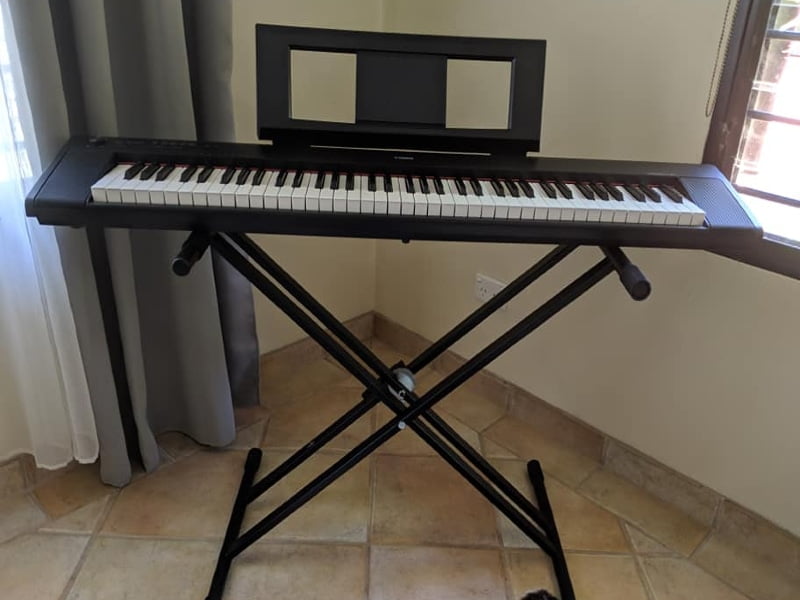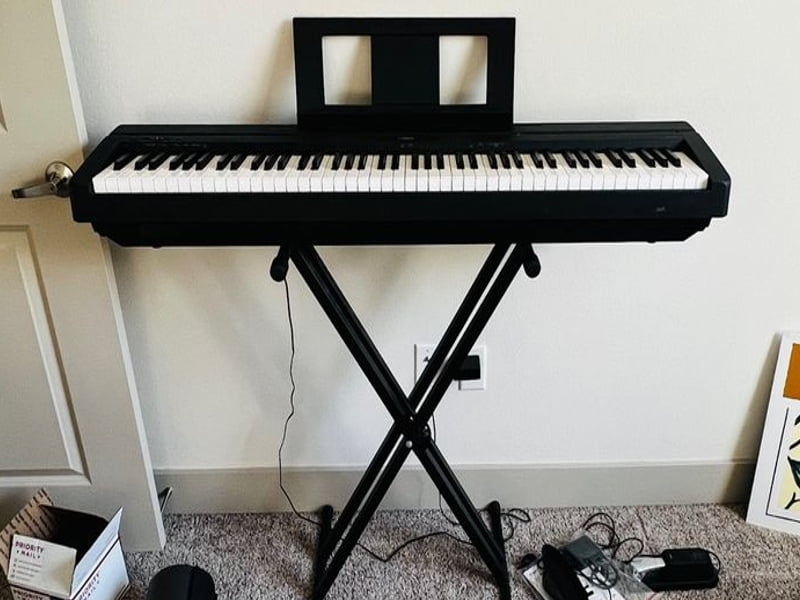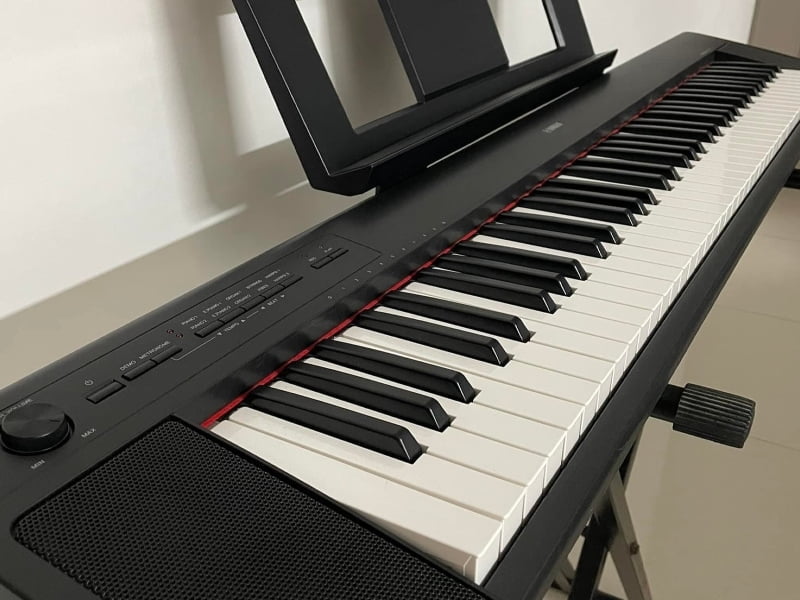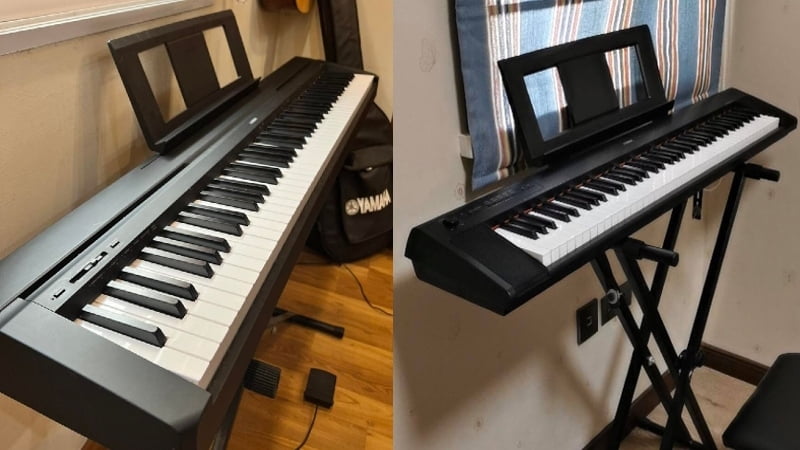Which piano is worth your money? Find out more in this Yamaha P45 vs NP32 review!
When buying a digital piano, one of the first questions to ask yourself is whether to spend more on a real digital piano or save some money by getting a simple digital keyboard. The answer to this question really depends more on your needs and playing styles.
But one good way to figure out the best option for you is to compare a real digital piano with a digital keyboard. And two models that perfectly fit into this comparison are the Yamaha P45 and the Yamaha NP32.
The P45 is a classic budget-friendly digital piano, while the NP32 is more of a digital keyboard. And while they are made for different musicians, I found that the P45 offers a bit more value for the money. Granted, the P45 is more expensive, but it has features that are perfect for beginner and novice pianists.
That said, the NP32 might still be the better option for pianists looking for a lightweight, affordable, and great-sounding piano.
To help you choose the right model for your needs, I’ll lay out all the features of both models in this Yamaha P45 vs NP32 review. So, keep reading to learn whether the portable digital piano or the portable digital keyboard is the right pick for you.
Yamaha P45 vs NP32: Comparison Chart
Last update on 2025-07-06 / Affiliate links / Images from Amazon Product Advertising API
Yamaha P45 vs NP32: The Features
These are very different instruments. This is why I decided to make a head-to-head feature comparison to figure out which one was the better option. And after rigorous testing and research, the score was 3-2 in favor of the Yamaha P45.
Even if it’s the more expensive option, it only edged out the NP32 by one point. So, let’s dive deeper into the features so you can better understand which piano is the best fit for your needs.
Tone
The winner: Tie
A great place to start when comparing two pianos is the tone. There was no way I could make a proper comparison without conducting a tone test. And between the two pianos, I couldn’t determine a winner.
Both of the pianos have great tones and a very similar sound library. So, when it comes to the sound options and quality of the piano, both models would serve you well. We’ll take a closer look at the tone of these two pianos to give you a better idea of how they sound.

+Sound Library
These two pianos have almost the same sound library. Right out of the box, they come with 10 voices each. Granted, this isn’t the largest sound library you can find, but the pianos have all the voices you’ll need to play various musical styles.
To start, both pianos have a fair share of acoustic and electric piano voices. This means you’ll have many choices for the piano timbre of the instrument. That way, you can choose a brighter piano for happier songs or a darker piano when you want a warmer tone.
On top of that, they come with a couple of organs, strings, and vibraphone voices. This offers a lot of versatility and is the reason why you can use both pianos for various musical genres. Whether you play classical, rock, jazz, or even blues music, these pianos will have the right voices for you.
+Tone Generation
Usually, only having 10 voices is a huge con. However, I found that I didn’t mind the smaller sound library on these pianos because of the very high-quality tones you can find on both instruments.
This is largely because the pianos use AWM stereo sampling, which is a cost-effective tone-generation system that produces very bright and rich tones. As the name suggests, this system still uses samples to play sounds, but I have to say the samples on these pianos are much better than the ones you’d typically find on a budget-friendly digital piano.
When recording the samples, Yamaha used top-of-the-line equipment and ensured that the samples contained a lot of sonic information to replicate the sound of the real instruments perfectly.
I tired all the voices on both pianos. I found that both of them produce very high-quality voices because of the samples that Yamaha loaded into them. And in this price range, you’ll have a very hard time finding a piano that can compare to either of these models.
Feel & Playability
The winner: Yamaha P45
The one area where the Yamaha P45 was the clear winner was in the feel and playability. Since this has GHS keys and a real hammer action system in place, you have just the right resistance when pressing the keys. That way, the piano replicates the feel of a real acoustic piano. The NP32, on the other hand, doesn’t have the same features, which was a slight letdown when testing it out.

+Hammer Action
The Yamaha P45 uses the GHS or Graded Hammer Standard of Yamaha. This hammer action system aims to replicate the subtle weight differences you might feel when playing a real acoustic piano. That way, the lower end of the piano has much heavier keys than the higher end.
This is a very small detail that makes a huge difference. I found that the GHS system does a great job of replicating the actual weight I feel when playing an acoustic piano. So, if you’re looking for a bit more realism when playing, the Yamaha P45 is a great option.
On the flip side, the Yamaha NP32 doesn’t have a GHS system. Instead, it uses a Graded Soft Touch hammer action. This is nowhere near the resistance you feel on an acoustic piano and is actually closer to the feel of a classic organ.
The keys on the NP32 are spring-loaded, so you have a bit of a bounce back when you press down them. But if you’re looking for a weight that replicates a real acoustic piano, you will be letdown by this piano.
On top of that, the Yamaha P45 has a full 88-key keyboard, like an acoustic piano. The Yamaha NP32, since it’s supposed to be more lightweight and portable, only has 76-keys so that you won’t have the full range of an acoustic piano on this model.
Piano Features
The winner: Yamaha P45
Another comparison point I had with these two pianos was the piano features. Specifically, I chose to compare the various playing modes on each piano to see which one offers more versatility.
It wasn’t a surprise, but the Yamaha P45 ended up taking the point, which is something I’d expect from the more expensive model.
+Playing Modes
The Yamaha P45 contains dual and duo modes. These are great playing modes to have on a digital piano, as it allows you to unlock various new sounds and tones. With the dual mode, you can blend two voices together to create a unique sound that only comes from the Yamaha P45.
And with duo mode, you can divide the piano into two separate zones. Each zone has the exact same timbre and tuning, which allows you to play piano duets on the same piano. This is not just great for playing with other people, but it’s also an awesome feature to have during piano lessons to make things much easier.
The Yamaha NP32 only has dual mode. And while blending two voices is a great way to add to the piano’s versatility, it would have been nice to see duo mode as well. But since the Yamaha NP32 doesn’t have a full range of keys, it’s understandable why they didn’t put a duo mode on this piano.
Price

The winner: Yamaha NP32
One area where the NP32 was the clear winner was the price. Remember, these two pianos have identical sound libraries and tone engines. And while the Yamaha P45 is closer to the $1,000 mark, the NP32 stays well below $400.
So, if you’re on a tight budget but still want a high-quality piano that produces great tones, the NP32 is a good option. That said, be prepared to miss out on some crucial playing modes and features with the NP32, such as weighted keys.
But for buskers, performing musicians, or beginners, the NP32 definitely offers much value for the money.
Yamaha P45 vs NP32: The Similarities
While I spent most of this comparison highlighting the differences between the two pianos, it’s also worth noting that they have a fair share of similarities. To start, they have the same tone engine and sound library. So, whatever sounds you have on the P45 will be available on the NP32.
On top of that, both pianos have 64-note maximum polyphony. And while this isn’t the best polyphony you can get on a digital piano, it’s more than enough for most pieces that don’t require a ridiculous number of notes.
Additionally, the pianos both come with the same reverb effects. This allows you to add much more depth to your tone and take control over your sound. And even if this is a fairly subtle feature, you’ll be surprised how much difference there is when you add a touch of reverb to your sound.
One complaint I had with both pianos was the fact that they used glossy plastic keys. While this is standard in the price range, glossy plastic keys feel very different from real piano keys and can get in the way of your playing. While this isn’t a deal-breaker, it’s something worth noting.
I didn’t expect the pianos to have real wooden keys. However, it would’ve been great if there was some sort of coating on the keys to mimic the feel of the wooden keys on an acoustic piano.
But aside from that, these are still very different pianos. The P45 is designed for pianists that are looking for a realistic digital piano to use for rehearsals, practice, and performances. The NP32, on the other hand, is best for people that don’t need sophisticated hammer action systems and just want a good-sounding piano that’s easy to carry around.
So, they both have their ideal market and offer much value for the money. And at the end of the day, it’s up to you to choose which one is the best fit for your needs.
Quick Rundown of the Yamaha P45
- Includes the P45 Digital Piano, power adapter, sustain pedal and music rest
- 88 fully weighted piano style keys simulate the feel of an acoustic piano and provide a quality playing experience
- GHS weighted action is heavier in the low end and lighter in the high end, just like an acoustic piano
- Contains 10 different voices, including digitally sampled tones from real Yamaha acoustic grand pianos
- Dual mode lets you combine 2 voices together, like piano and strings, for an inspiring new playing experience. Tuning- 414.8 - 440.0 - 446.8 Hz
Last update on 2025-07-06 / Affiliate links / Images from Amazon Product Advertising API
Quick Rundown of the Yamaha NP32
- 76-Key Graded Soft Touch (GST) keyboard action provides gentle weighting, whilst retaining the soft touch of a digital keyboard
- Advanced Wave Memory Stereo Sampling recreates natural instrument sound in stereo
- The controller App for iOS adds a rich, graphic user interface allowing for quick and easy navigation and configuration
- The USB to Host port allows you to connect and interact with a wide variety of educational and musical creation Apps on a computer or mobile device
- Additional upgrades include 64-note polyphony, a song recorder function, and extended battery life
Last update on 2025-07-06 / Affiliate links / Images from Amazon Product Advertising API
Product Videos
Related Articles to Yamaha P45
- Yamaha P45 vs P45B: What’s the Real Difference?
- Yamaha P45 vs DGX-650: Is the DGX-650 Worth the Higher Price?
- Yamaha P-35B vs P45: Finding the Best Affordable Yamaha Piano
- Yamaha P45 Vs DGX-660: A Head-to-Head Comparison
- Yamaha P45 vs Williams Rhapsody II: A Head-to-Head Comparison
- Yamaha P45 vs Williams Allegro III: Finding the Best Digital Piano on a Budget
- Yamaha P45 vs YPG 535: Which Is the Best Affordable Yamaha Piano?
- Yamaha P60 vs P45: Finding the Best Yamaha Portable Digital Piano
- Yamaha P45 vs P105: Should You Spend Extra for the P105?
- Alesis Recital Vs Yamaha P45: Which Offers Great Value For Money?
- Donner DEP-10 Vs Yamaha P-45: Which Digital Piano Is Better?
- Yamaha P45 Vs Korg B2: Which Digital Piano Fits Beginners Better?
- Yamaha P45 VS P115: Which P-Series Newbie Gives You More Value for Money?
- Yamaha P45 vs Casio CDP S100: Finding the Better Bet for Beginners
- Yamaha P45 vs YDP 103: Should You Get a Portable or Console Digital Piano?
- Alesis Recital Pro vs Yamaha P45: Which Should You Get As Your First Piano?
- Yamaha P45 vs Roland FP10: Which Entry Level Titan Takes the Top Spot?
- Yamaha P45 vs Donner DEP 20: Which Model Is the Better Option for Beginners?
- Yamaha P45 vs Casio PX 770: Should You Get the Portable or Console Digital Piano?
- Alesis Prestige Artist vs Yamaha P45: Can Alesis Hold Its Own Against the Popular Yamaha Model?
- Yamaha P45 vs P125: Why the Yamaha P125 Is the Better Pick for Pianists
- Yamaha P71 vs P45: Why the Amazon Exclusive P71 is the Better Digital Piano
Related Articles to Yamaha Np32
- Alesis Recital Pro vs Yamaha NP32 Comparison: Discover the Best Piano for Your Home
- Alesis Recital Vs Yamaha NP32: Which Is Better For Beginners?
References:
- Yamaha P45: https://usa.yamaha.com/products/musical_instruments/pianos/p_series/p-45/specs.html#product-tabs
- Yamaha NP32: https://usa.yamaha.com/products/musical_instruments/keyboards/piaggero/np-32_12/specs.html#product-tabs
Lulacruza is an electronic folk duo operating at the junction of the hypermodern and the ancient. Our music weaves together hypnotic female singing, South American folk instruments and electronic processing, while channeling pulsating waves from the source of creation.
Lalucruza is also a community where you can connect with other music lovers to collaborate, exchange ideas and share knowledge. A platform for who wants to learns the basics of playing piano, guitar, drum masters’ technique, etc.. is the premise of our website.
